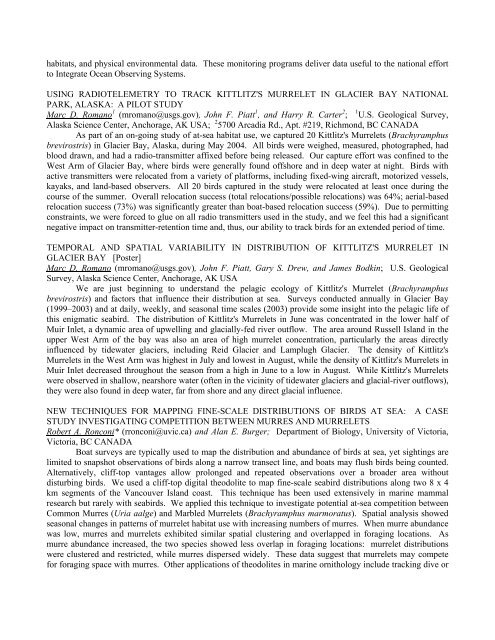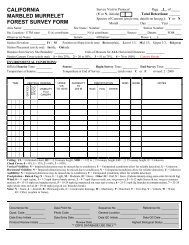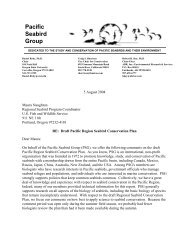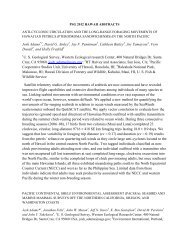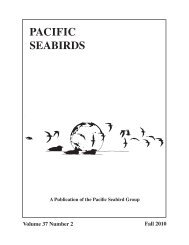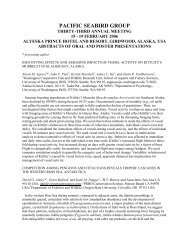abstracts of oral and poster presentations - Pacific Seabird Group
abstracts of oral and poster presentations - Pacific Seabird Group
abstracts of oral and poster presentations - Pacific Seabird Group
You also want an ePaper? Increase the reach of your titles
YUMPU automatically turns print PDFs into web optimized ePapers that Google loves.
habitats, <strong>and</strong> physical environmental data. These monitoring programs deliver data useful to the national effort<br />
to Integrate Ocean Observing Systems.<br />
USING RADIOTELEMETRY TO TRACK KITTLITZ'S MURRELET IN GLACIER BAY NATIONAL<br />
PARK, ALASKA: A PILOT STUDY<br />
Marc D. Romano 1 (mromano@usgs.gov), John F. Piatt 1 , <strong>and</strong> Harry R. Carter 2 ; 1 U.S. Geological Survey,<br />
Alaska Science Center, Anchorage, AK USA; 2 5700 Arcadia Rd., Apt. #219, Richmond, BC CANADA<br />
As part <strong>of</strong> an on-going study <strong>of</strong> at-sea habitat use, we captured 20 Kittlitz's Murrelets (Brachyramphus<br />
brevirostris) in Glacier Bay, Alaska, during May 2004. All birds were weighed, measured, photographed, had<br />
blood drawn, <strong>and</strong> had a radio-transmitter affixed before being released. Our capture effort was confined to the<br />
West Arm <strong>of</strong> Glacier Bay, where birds were generally found <strong>of</strong>fshore <strong>and</strong> in deep water at night. Birds with<br />
active transmitters were relocated from a variety <strong>of</strong> platforms, including fixed-wing aircraft, motorized vessels,<br />
kayaks, <strong>and</strong> l<strong>and</strong>-based observers. All 20 birds captured in the study were relocated at least once during the<br />
course <strong>of</strong> the summer. Overall relocation success (total relocations/possible relocations) was 64%; aerial-based<br />
relocation success (73%) was significantly greater than boat-based relocation success (59%). Due to permitting<br />
constraints, we were forced to glue on all radio transmitters used in the study, <strong>and</strong> we feel this had a significant<br />
negative impact on transmitter-retention time <strong>and</strong>, thus, our ability to track birds for an extended period <strong>of</strong> time.<br />
TEMPORAL AND SPATIAL VARIABILITY IN DISTRIBUTION OF KITTLITZ'S MURRELET IN<br />
GLACIER BAY [Poster]<br />
Marc D. Romano (mromano@usgs.gov), John F. Piatt, Gary S. Drew, <strong>and</strong> James Bodkin; U.S. Geological<br />
Survey, Alaska Science Center, Anchorage, AK USA<br />
We are just beginning to underst<strong>and</strong> the pelagic ecology <strong>of</strong> Kittlitz's Murrelet (Brachyramphus<br />
brevirostris) <strong>and</strong> factors that influence their distribution at sea. Surveys conducted annually in Glacier Bay<br />
(1999–2003) <strong>and</strong> at daily, weekly, <strong>and</strong> seasonal time scales (2003) provide some insight into the pelagic life <strong>of</strong><br />
this enigmatic seabird. The distribution <strong>of</strong> Kittlitz's Murrelets in June was concentrated in the lower half <strong>of</strong><br />
Muir Inlet, a dynamic area <strong>of</strong> upwelling <strong>and</strong> glacially-fed river outflow. The area around Russell Isl<strong>and</strong> in the<br />
upper West Arm <strong>of</strong> the bay was also an area <strong>of</strong> high murrelet concentration, particularly the areas directly<br />
influenced by tidewater glaciers, including Reid Glacier <strong>and</strong> Lamplugh Glacier. The density <strong>of</strong> Kittlitz's<br />
Murrelets in the West Arm was highest in July <strong>and</strong> lowest in August, while the density <strong>of</strong> Kittlitz's Murrelets in<br />
Muir Inlet decreased throughout the season from a high in June to a low in August. While Kittlitz's Murrelets<br />
were observed in shallow, nearshore water (<strong>of</strong>ten in the vicinity <strong>of</strong> tidewater glaciers <strong>and</strong> glacial-river outflows),<br />
they were also found in deep water, far from shore <strong>and</strong> any direct glacial influence.<br />
NEW TECHNIQUES FOR MAPPING FINE-SCALE DISTRIBUTIONS OF BIRDS AT SEA: A CASE<br />
STUDY INVESTIGATING COMPETITION BETWEEN MURRES AND MURRELETS<br />
Robert A. Ronconi* (rronconi@uvic.ca) <strong>and</strong> Alan E. Burger; Department <strong>of</strong> Biology, University <strong>of</strong> Victoria,<br />
Victoria, BC CANADA<br />
Boat surveys are typically used to map the distribution <strong>and</strong> abundance <strong>of</strong> birds at sea, yet sightings are<br />
limited to snapshot observations <strong>of</strong> birds along a narrow transect line, <strong>and</strong> boats may flush birds being counted.<br />
Alternatively, cliff-top vantages allow prolonged <strong>and</strong> repeated observations over a broader area without<br />
disturbing birds. We used a cliff-top digital theodolite to map fine-scale seabird distributions along two 8 x 4<br />
km segments <strong>of</strong> the Vancouver Isl<strong>and</strong> coast. This technique has been used extensively in marine mammal<br />
research but rarely with seabirds. We applied this technique to investigate potential at-sea competition between<br />
Common Murres (Uria aalge) <strong>and</strong> Marbled Murrelets (Brachyramphus marmoratus). Spatial analysis showed<br />
seasonal changes in patterns <strong>of</strong> murrelet habitat use with increasing numbers <strong>of</strong> murres. When murre abundance<br />
was low, murres <strong>and</strong> murrelets exhibited similar spatial clustering <strong>and</strong> overlapped in foraging locations. As<br />
murre abundance increased, the two species showed less overlap in foraging locations: murrelet distributions<br />
were clustered <strong>and</strong> restricted, while murres dispersed widely. These data suggest that murrelets may compete<br />
for foraging space with murres. Other applications <strong>of</strong> theodolites in marine ornithology include tracking dive or


